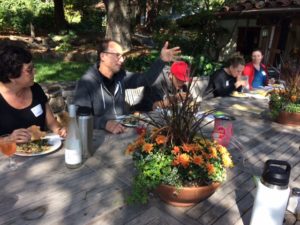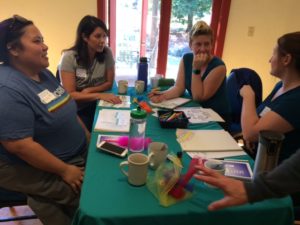Facilitating Relaxation, Part One: Location, Location, Location
Last week I had the honor of hosting a retreat at the gorgeous Westerbeke Ranch in Sonoma, California. This was an idea that my Spark Decks’ business partner, Oscar, and I had come up with last spring: Could we take the workshop training-of-trainers model we had established, and make it even more meaningful and transformative? Yes. We could.
Let me back up for just a second. Since some of you may not be familiar with Spark Decks, they are a tool designed to help educators and parents learn on-the-job. Each card in a deck contains a little micro-practice – an idea to get you started. Your work as the user is to try out the idea, with your child at home or with your students at school, modifying the activity or practice to suit the children you are working with, and then reflect on how it went afterwards: what worked? what didn’t? what did you learn? etc.
We have decks on over a dozen different topics, including positive behavior guidance, building social and emotional learning skills, math, literacy, supporting English Language Learners, and more. If you haven’t already, definitely check out our website to see what it all looks like.
For several years Oscar and I offered a free training-of-trainers on the decks, where people could come and learn how to run our workshops (which are very hands-on, fun, and model all of the transformational facilitation practices that I write about on this blog). That way they could bring them back to their staff wherever they work – or help us out when we needed someone to step in for us.
One of the things that struck us strongly was that at each of these training-of-trainer events we had incredible and highly experienced leaders and facilitators from all over the SF Bay Area and beyond in attendance. How could we capitalize on the voices in the room to help them get to know each other better, thereby building a stronger team of youth-serving professionals? At the same time, how could we make the event more enjoyable and relaxing for everyone, including ourselves as facilitators of the event?
Since heading to Hawaii seemed overly ambitious for our first retreat, we decided to look at locations within a 1-2 hour drive of San Francisco. We looked at overnight options, as well as day-use options. One of the things we had learned from running our Self Care for Youth-Serving Professionals workshop so many times is that water and nature are ubiquitous themes for high quality relaxation. Being near the ocean or a swimming pool became central. Good food, beautiful scenery, space to unwind and walk around… this is what we were looking for. Our past training-of-trainers events had been in local room-for-rent spaces. They were functional, but not inspiring. This was going to be different.
We surveyed past training-of-trainer participants and people who we thought might like to attend, and found out that the only way an overnight would work is if we could find a space where everyone could have their own room. As it turns out, many of the retreat centers nearby only offer shared rooms and single rooms are very expensive, if even available. We also asked our contacts whether a weekday or weekend would be easier (weekday!), and what a reasonable price range would be (that one really ran the gamut).
We then hit the road, visiting a number of wonderful spaces, including an AirBnB on a horse farm, before deciding that the Westerbeke was definitely the place for us. Pool, hot tub, farm-to-table meals (you really have no idea how delicious the food there is!!!!), open and airy meeting rooms, a meditation labyrinth, gardens and grounds where we could eat fruit off of the trees (figs!). This was definitely it. A little slice of paradise.

Facilitating an all day event can be utterly exhausting. But I left Westerbeke feeling like I, myself, had been on a retreat. So here’s my task for you all: Think about WHERE you are holding your meetings and events and the environment you are creating. Even if you cannot move your location, think about how you are using the space, making it beautiful, comfortable, accessible. Is there an opportunity for people to flow in and out, take a break, move their seat? Can you put flowers, seashells, or pretty tablecloths on the tables, or open the windows? Perhaps you can play the sounds of the ocean or forest as people are entering the room. Can you upgrade your snacks a little, so people feel just that much more cared for than usual, put sliced lemons or mint into the water pitchers, use fancier bowls or mugs? Try it out and let me know how it goes: Did your meeting or class feel more productive, fun, relaxing? I’d love to hear your thoughts about this!

